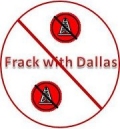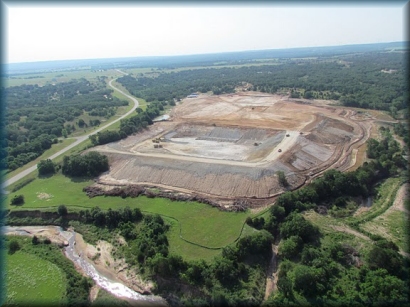 |
 |





 |








 |
    |
Land Destruction from Mining Operations One of the major concerns regarding frac sand mining is the tremendous destruction it causes to the quarry area, surrounding natural areas including fields, forests, glades, rivers, creeks, lakes, farms, ranches, residences and our infrastructure, particularly our roadways where trucks transports thousands of tons of sand from the quarries to drilling sites. This destruction is pervasive, invasive and very harmful to property values. It risks contamination of creeks and rivers that serve as habitat and breeding grounds for fish and wildlife. And, it pollutes the air that we all breath with carcinogenic crystalline silica dust paticulate matter.
Looking at a quarry site reminds one of the copper strip mines of Arizona - nothing is left standing and the ground is scraped bare. There is no vegetation because that would interfere with sand removal and traffic routes at the site. All that one sees is acres of brown, tan and grey soil populated by an occasional building for sand washing or a worker shack for office space and eating. Trucks and heavy mining equipment are everywhere. Noise levels are "strictly industrial level". In most cases dust is flying, and part of that dust may be crystalline silica dust, a known human carcinogen that buries itself in the skin and lung tissue of humans and animals.  Photo use courtesy of Save the Trinity Aquifer The photo above, used with permission from Save the Trinity Aquifer is a prime example of how frac sand mining changes the landscape from something natural and beautiful to a desolate, barren wasteland of industrial activity. This particular sand mine sits immediately adjacent to a creek into which its wastewater will be discharged resulting in bank erosion of the creek and eventual destruction of critical fish spawning grounds of the river into which it empties and the reservoir that is formed by damming the river. As anybody can plainly see, this land can never be reclaimed and remediated back to its original characteristics. Digging and deep soil and sand removal will forever make this an inhospitable land mass that is useless for anything other than some industrial activity, even if it is not continued as a frac sand mine operation. In the Arkansas Ozarks, particularly near Izard County, mountaintop removal is being used to mine sand in the White River Basin. This is a lush, verdant area of tree-covered mountains, bluffs and forests where "The Natural State" is defined. It starts with denuding the mountaintop of all vegetation, which then causes tremendous erosion and loss of soil stability. Evergreen Processing, LLC near Calico Rock has applied for and received a stormwater permit on 200 plus acres, an open quarry mining permit and an air permit for their "Twin Mountain" quarry. Twin Mountain is essentially a mountain top removal project that will be operating around the clock and running 70 truck loads per day. Evergreen is currently considering a spring as the source for process water. Next comes blasting and digging leading to the same types of "vistas" that you see when looking at those Arizona copper mines. The water used to wash the sand is heated in the process to a temperature many degrees warmer than the natural water, and then it runs down the mountain into the North Fork and White Rivers where it begins to disrupt trout habitat. Trout fishing is a $100 million a year industry in this part of Arkansas, but the oil and gas companies are not getting any of that money, so they are not concerned with disrupting the local economy because they are "bringing jobs" and "increasing revenues" to the local communities that they are displacing with their mining process. Wisconsin Industrial Sand mines 3,000 tons of sand per day and after washing, sifting and drying, loads 25 rail cars with dry sand daily. Each rail car carries 100 tons of sand. One cubic foot of dry sand weighs roughly 100 pounds. It is the same story everywhere - in Wisconsin, Arkansas, North Texas, West Texas, Colorado, Wyoming, Ohio, Virginia, Pennsylvania - everywhere natural gas drilling is occurring. Land that once thrived with an abundance of natural foliage and wildlife is suddenly and irrevocably destroyed for the benefit of the oil and gas industry which refuses to realize that the days of fossil fuels are coming to an abrupt end sooner rather than later. But, destruction of the quarry area is hardly the end of the story. The Twin Mountain quarry of Evergreen Processing LLC near Calico Rock in the White River Basin of Arkansas plans a 200 acre operation that will remove, wash and transport sand 24 hours a day, 7 days a week, year round. They estimate that they will move 70 truckloads of sand per day. One cubic foot of dry sand weighs approximately 100 pounds, so imagine the weight of a truckload of sand drivng on public roadways and destroying them at taxpayer expense to maintain and repair. A proposed sand mine in Cooke County, Texas on the banks of Mountain Creek and near the Red River proposes to use 3,700 gallons of fresh water per minute to wash sand before transporting it by truck and rail. One railcar holds about 100 tons of sand, so it is going to take a lot of truck traffic to move enough sand to a railcar to justify the expense of shipping it by rail to a gas drilling site many miles away. And, it is going to require a lot of fresh water for the washing operation. In fact, the Enron Oil and Gas (EOG) site will use as much water in one year as is used by about 53,280 people. And, all that produced sand will have to move by truck on county and state roadways to drilling sites or to rail yards resulting in road damage, noise pollution, and inevitably, traffic accidents including possible sand spills with the attendant problem of creating airborne crystalline silica dust pollution and all the health hazards associated with it. Destruction caused by frac sand mining is pervasive and long-lasting. It touches people near quarry sites and many miles away who are exposed to carcinogenic dust particulates. It caused severe destruction of the natural environment including the ground, creeks and rivers, air, property values near quarries and road damage due to heavy truck traffic. These are the legacy of this element in the issue of hydraulic fracturing for natural gas and oil, and the price paid by the general public translates into profits for the drilling and mining companies at our expense. Next: Noise and Light Pollution Issues
|
Friends of the North Fork and White Rivers |